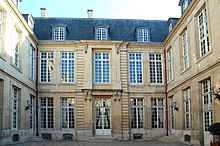Hotel particulier
Hôtel particulier is an established architectural term for a city palace in France , without a literal equivalent in the German language .
Content, the designated mansion , the town house of the 17th and 18th century, the wealthy members of nobility , clergy , and in the 18th century in some cases of privileged civil officials. The majority of the municipal private houses of the third estate were referred to as Maison particulière , in contrast to the Hôtel particulier .
The hotel finds its rural equivalent in the Château , the manor house .
term
The term Hôtel particulier is made up of the word hôtel (French; old French: hostel , Latin: hospitalis , neulat .: hospitale = hospitable) and the word particulier (French: private) . Unlike today, the concept of privacy is not understood as a counterpart to the professional , but as something “hidden from the public”.
This apparent contradiction is also made clear in the two basic functions that the Hôtel particulier had to fulfill: representation within the public life of society and the withdrawal of the members of the family of a house .
The various apartments and their weighting corresponded to these functions . In addition to the rooms that were used for living (apartment privé) , the parade apartment (apartment de parade) fulfilled the task of representing the family. The character of the Hôtel particulier was first and foremost a public one. The public in the Ancien Régime was formed by the aristocratic members of the court environment. All others were excluded from it and lived privately as “outsiders”.
In German usage, the term Stadtpalais is also used for the Hôtel particulier . In France, however, the Hôtel particulier is separated from the term Palais . In contrast to the hotel, the owner of a palace is entitled to hold court. In France this affected only a few members of the royal family and high clergy. The requirements of a court and the associated representational tasks resulted in different room dispositions with regard to the size, number and differentiation of the rooms in an apartment. In a palace, in terms of quantity and quality, these requirements went beyond the dimensions of a hotel.
Type and development
The typological basic form of the Hôtel particulier is based on the Cardinal of Ferrara at the Château who was related to the Valois family and was friendly with King Francis I in the years 1544–1546 by Sebastiano Serlio for Hippolyt II. D'Este (1509–1572) de Fontainebleau built Hôtel de Ferrare (Grand Hôtel de Ferrare) . In France, for more than two centuries, this became the model of the town house for the privileged members of the estates . Starting from Paris , this type of building developed in the 16th and 17th centuries. In the 18th century, the Hôtel particulier became the European model of the elegant townhouse.
In architecture , the term is used about the functional description addition, the typological description of the arrangement of the building - ensembles .

The original basic principle is a U-shaped grouping of three buildings. The middle part of the building was called the Corps de Logis . In the 18th century this part of the three-wing building was also called the palace . This central building connects the wing structures on both sides. Together they enclose the Cour d'Entrée on three sides. In the 18th century, the original three-wing structure was supplemented by another building and the courtyard facing the street was closed off. Access is through a centrally positioned gate . The garden was usually attached to the rear of the corps de logis .
The internal structure of the Hôtel particulier corresponds to the formal and symmetrical design and grouping of the buildings . As a rule, the representative rooms are located in the middle main wing, the Corps de Logis . The side wings, often narrower and arranged in mirror image, were used to accommodate the living room and bedroom, the private apartments of the lady and the gentleman of the house. The fourth wing to the street, which was added later, usually housed subordinate and serving rooms as a stable or kitchen building.
In addition to numerous changes in the weighting and development of the rooms over the long time in which this type of building existed, one of the fundamental changes at the beginning of the 18th century is the introduction of another type of apartment. For ceremonial used Parade Apartment (Appartement de parade) and the serving retreating private apartment (apartment privé) , which in the 18th century than Appartement de comodité called and baths (Appartement de Bains) has been extended, the company apartment came (Appartement de société) added . It was used for social entertainment.
In Paris, in particular in the districts of Marais , Faubourg Saint-Honoré and Faubourg Saint-Germain, a large number of these art-historically significant city residences from the period from the late 15th to the 18th centuries have been preserved. The Marais quarter became acceptable in the 17th century after King Henry IV set an urban accent with the Place des Vosges .
A counter-development can be observed in the second half of the 17th century: With the increasing development of absolutist kingship, the nobility was relegated to their place and renounced the demonstrative display of rank and wealth. The nobility settled in larger complexes such as the Place Vendôme ; The king's relatives were exceptions.
In the 18th century, more city palaces were built again, but now mainly in the western districts of Faubourg Saint-Germain and Faubourg Saint-Honoré , which were then on the outskirts . Outwardly reserved, the buildings inside revel in playful Rococo .
Individual evidence
- ↑ His brother Ercole II. D'Este , Duke of Ferrara , Modena and Reggio , married Renée de France (1510–1575), daughter of King Louis XII. .
See also
- Hôtel particulier in Paris
- Hôtel de ville (town hall)
- Hôtel-Dieu (hospital)
- City Palace